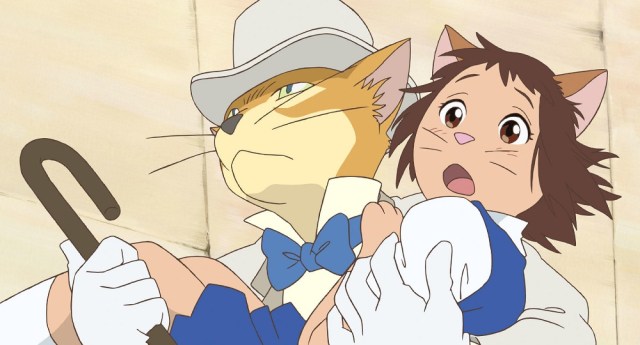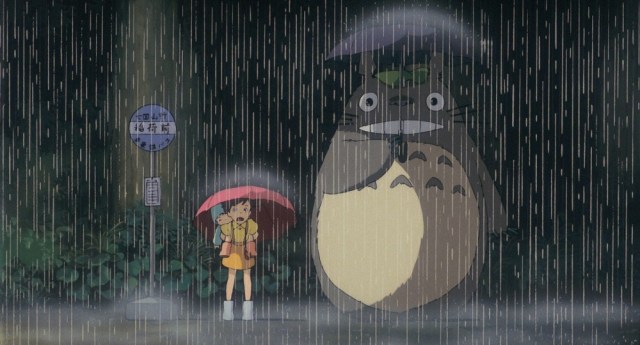Just a few weeks ago, When Marnie Was There, the newest anime movie from Studio Ghibli, hit Japanese theatres. Marnie is actually the second Ghibli release since legendary director Hayao Miyazaki retired from the company, but the first with a general, mainstream target market, as 2013’s The Tale of Princess Kaguya was a much more experimental, avant-garde film in visual style and tone.
Just as Miyazaki has stepped away from feature films, Ghibli producer and co-founder Toshio Suzuki is easing into retirement, and so many anime fans have been watching Marnie while looking for clues as to where Ghibli’s films would be going from here. Judging from statements made by Suzuki, though, the better question isn’t what kind of movies Ghibli will be making in the future, but whether the studio will be making any at all, as he feels that maybe it’s time for the Ghibli production team to close up shop.
In a series of screen captures from Japanese television, Suzuki can be seated at a table conversing with a group of men, none of whom look particularly happy.
Looking concerned and more than a little tired, Suzuki turns to the other and says:
“My choice of words might be a little harsh, but I’m wondering if we shouldn’t dismantle the production division.
“Maybe I should say “restructure” or “reconstruct.”
“When I stop and think about it, Miyazaki retiring is just something we can’t ignore.”
“This might be a point where we should take a hiatus for a while, and think about what we’re going to do from now.”
In one way of looking at things, it’s a kind of shocking to see Studio Ghibli, which in the wake of Disney’s continuing shift to CG visuals has become arguably the most respected 2-D animation house in the world, ready to throw in the towel so soon after Miyazaki’s departure. Visionary though he may be, he wasn’t drawing every frame of Ghibli’s hits by himself. It’s also not like Miyazaki only graced the studio with his presence for a few shorts years, either. In the almost three decades Miyazaki was with Studio Ghibli, it seems like the old guard should have been able to find and nurture at least some younger talent that could carry on the sensibilities and techniques pioneered by Miyazaki, Suzuki, and Isao Takahata, the remaining Ghibli co-founder.
On the other hand, one could also take the tack that Studio Ghibli has always been, in essence, the Hayao Miyazaki Show. The studio’s film catalogue contains only seven films in which Miyazaki didn’t serve as either director or writer: Grave of the Fireflies, Only Yesterday, Pom Poko, My Neighbors the Yamadas, The Cat Returns, Tales from Earthsea, and The Tale of Princess Kaguya. Excepting the well-respected Grave of the Fireflies, that list reads very much like the second string lineup of Ghibli films.
▼ This isn’t the first thing many people think of when they hear the words “Studio Ghibli.”
▼ This, however, is.
In contrast, what are essentially the studio’s greatest hits came from times when Miyazaki handled both directing and writing duties: Castle in the Sky Laputa, Totoro, Kiki’s Delivery Service, Princess Mononoke, Spirited Away. With this in mind, maybe Suzuki’s suggested dissolution of the production division isn’t so drastic, considering that the one common element in the majority of Ghibli’s critically and commercially successful theatrical anime says he’s done with making them.
It’s also worth noting that Suzuki is talking specifically about the production division, therein implying that Ghibli itself would continue to exist in some capacity, most likely licensing, merchandising, and other associated management activities for its intellectual properties. It would be impossible for Ghibli to absorb all of its animators into those divisions, though, nor is it likely all of the studio’s artists have an aptitude for such administrative work, anyway.
So if Ghibli decides to follow the course Suzuki is suggesting, the question arises of what will happen to its animation staff during the period of “think about what (it’s) going to do from now.” While some veterans may be able to wait out the Ghibli identity crises (which some still believe will only come to an end if and when Miyazaki comes out of retirement once again), the base pay for animators in Japan is notoriously low. Simply taking a sabbatical won’t a viable economic option for most of Ghibli’s animators. Even if Ghibli, at some point down the road, should decide to get back into making movies and put out the call for its old production team members to assemble, many would have since signed on with other studios.
In other words, even a temporary dissolution would translate into a permanent loss of certain Ghibli animators, and yet another break with the traditions the studio established which led it to its exalted position in the industry.
As part of the media blitz surrounding the release of Marnie, Suzuki was asked for his opinion of the film. “It feels very young,” he replied, elaborating that he was including the positive and negative implications of the description. Part of growing up is learning to make your own way in the world, whether that means birds flying away from the nest, children moving out of their parents’ house, or, as may be the case for Ghibli’s anime makers, leaving the studio they called home.
Source: Jin, 情熱大陸(Jounetu Tairiku)
Insert images: Studio Ghibli (1, 2)



 Studio Ghibli producer dishes the dirt on Hayao Miyazaki, Your Name, and their next big project
Studio Ghibli producer dishes the dirt on Hayao Miyazaki, Your Name, and their next big project Studio Ghibli co-founder and anime director Isao Takahata passes away in Tokyo
Studio Ghibli co-founder and anime director Isao Takahata passes away in Tokyo Hayao Miyazaki has secret concept for next anime, considers all animators his rivals, son says
Hayao Miyazaki has secret concept for next anime, considers all animators his rivals, son says Poster for Ghibli’s new movie under fire … from the big guru himself!
Poster for Ghibli’s new movie under fire … from the big guru himself! Hayao Miyazaki spends retirement from anime by…spending every day at his animation studio
Hayao Miyazaki spends retirement from anime by…spending every day at his animation studio Japan’s new difficult-to-drink-from beer glass protects your liver, but it’s a brutal experience
Japan’s new difficult-to-drink-from beer glass protects your liver, but it’s a brutal experience Hello, cosmetics! Clinique teams up with Hello Kitty this summer for first-time collaboration
Hello, cosmetics! Clinique teams up with Hello Kitty this summer for first-time collaboration How to order snacks on a Shinkansen bullet train in Japan
How to order snacks on a Shinkansen bullet train in Japan Demon Slayer: Kimetsu no Yaiba gets new roller coaster attractions and food at Universal Studios Japan
Demon Slayer: Kimetsu no Yaiba gets new roller coaster attractions and food at Universal Studios Japan New samurai glasses are Japan’s latest weird must-have souvenir
New samurai glasses are Japan’s latest weird must-have souvenir Burger King Japan suddenly adds Dr. Pepper and Dr. Pepper floats to its menu nationwide
Burger King Japan suddenly adds Dr. Pepper and Dr. Pepper floats to its menu nationwide New Nintendo Lego kit is a beautiful piece of moving pixel art of Mario and Yoshi【Photos】
New Nintendo Lego kit is a beautiful piece of moving pixel art of Mario and Yoshi【Photos】 What do you eat when you catch a cold? We asked 11 of our Japanese reporters
What do you eat when you catch a cold? We asked 11 of our Japanese reporters High-fashion Totoro cuddle purse is like an elegant stroll in the forest【Photos】
High-fashion Totoro cuddle purse is like an elegant stroll in the forest【Photos】 Why Japanese doesn’t need swear words
Why Japanese doesn’t need swear words Nintendo history you can feel – Super NES, N64, and GameCube controllers become capsule toys
Nintendo history you can feel – Super NES, N64, and GameCube controllers become capsule toys “The most Delicious Cup Noodle in history” – Japan’s French Cup Noodle wins our heart【Taste test】
“The most Delicious Cup Noodle in history” – Japan’s French Cup Noodle wins our heart【Taste test】 Starbucks releases a cute Frappuccino and Unicorn Cake…but not in Japan
Starbucks releases a cute Frappuccino and Unicorn Cake…but not in Japan Kyoto Tower mascot termination reveals dark side behind cute Japanese characters
Kyoto Tower mascot termination reveals dark side behind cute Japanese characters McDonald’s Japan’s Soft Twist Tower: A phantom ice cream only sold at select branches
McDonald’s Japan’s Soft Twist Tower: A phantom ice cream only sold at select branches Yabai Ramen: What makes this Japanese ramen so dangerous?
Yabai Ramen: What makes this Japanese ramen so dangerous? Finally! Nintendo Japan expands Switch 8-bit controller sales to everybody, Online member or not
Finally! Nintendo Japan expands Switch 8-bit controller sales to everybody, Online member or not Japanese government wants to build luxury resorts in all national parks for foreign tourists
Japanese government wants to build luxury resorts in all national parks for foreign tourists To combat declining birth rate, Japan to begin offering “Breeding Visas” to foreigners
To combat declining birth rate, Japan to begin offering “Breeding Visas” to foreigners 10 things you should buy at 7-Eleven in Japan
10 things you should buy at 7-Eleven in Japan Studio Ghibli releases anime heroine cosplay dresses that are super comfy to wear
Studio Ghibli releases anime heroine cosplay dresses that are super comfy to wear Woman charged for driving suitcase without a license in Osaka
Woman charged for driving suitcase without a license in Osaka Studio Ghibli unveils My Neighbour Totoro miniature house model
Studio Ghibli unveils My Neighbour Totoro miniature house model Kyoto experiencing problems with foreign tourists not paying for bus fares, but not on purpose
Kyoto experiencing problems with foreign tourists not paying for bus fares, but not on purpose Fighting mild hunger with a Japanese soda that turns into jelly in the stomach【Taste test】
Fighting mild hunger with a Japanese soda that turns into jelly in the stomach【Taste test】 Studio Ghibli’s Howl’s Moving Castle tapestry unveiled in Japan for first time
Studio Ghibli’s Howl’s Moving Castle tapestry unveiled in Japan for first time McDonald’s new Happy Meals offer up cute and practical Sanrio lifestyle goods
McDonald’s new Happy Meals offer up cute and practical Sanrio lifestyle goods Sales of Japan’s most convenient train ticket/shopping payment cards suspended indefinitely
Sales of Japan’s most convenient train ticket/shopping payment cards suspended indefinitely Sold-out Studio Ghibli desktop humidifiers are back so Totoro can help you through the dry season
Sold-out Studio Ghibli desktop humidifiers are back so Totoro can help you through the dry season Japanese government to make first change to romanization spelling rules since the 1950s
Japanese government to make first change to romanization spelling rules since the 1950s Foreigner’s request for help in Tokyo makes us sad for the state of society
Foreigner’s request for help in Tokyo makes us sad for the state of society Ghibli founders Toshio Suzuki and Hayao Miyazaki contribute to Japanese whisky Totoro label design
Ghibli founders Toshio Suzuki and Hayao Miyazaki contribute to Japanese whisky Totoro label design Doraemon found buried at sea as scene from 1993 anime becomes real life【Photos】
Doraemon found buried at sea as scene from 1993 anime becomes real life【Photos】 Tokyo’s most famous Starbucks is closed
Tokyo’s most famous Starbucks is closed Princesses, fruits, and blacksmiths: Study reveals the 30 most unusual family names in Japan
Princesses, fruits, and blacksmiths: Study reveals the 30 most unusual family names in Japan Ghibli’s Boy and the Heron wins Academy Award, studio COO apologizes for Hayao Miyazaki’s absence
Ghibli’s Boy and the Heron wins Academy Award, studio COO apologizes for Hayao Miyazaki’s absence Studio Ghibli co-founder Toshio Suzuki receives lifetime achievement honor at Annie awards
Studio Ghibli co-founder Toshio Suzuki receives lifetime achievement honor at Annie awards Ghibli producer provokes backlash for comment regarding abilities of women to direct anime
Ghibli producer provokes backlash for comment regarding abilities of women to direct anime “Let’s leave it to Goro” – The moment Hayao Miyazaki was truly convinced about Ghibli theme park
“Let’s leave it to Goro” – The moment Hayao Miyazaki was truly convinced about Ghibli theme park SoraReview: Mary and the Witch’s Flower, the newest anime from Studio Ghibli director Yonebayashi
SoraReview: Mary and the Witch’s Flower, the newest anime from Studio Ghibli director Yonebayashi Studio Ghibli releases beautiful color vinyl record anime soundtrack series, available now【Pics】
Studio Ghibli releases beautiful color vinyl record anime soundtrack series, available now【Pics】 Studio Ghibli receives honorary Palme d’Or at Cannes Film Festival 【Videos】
Studio Ghibli receives honorary Palme d’Or at Cannes Film Festival 【Videos】 Hayao Miyazaki is getting worried about how his new anime is being marketed, Ghibli producer says
Hayao Miyazaki is getting worried about how his new anime is being marketed, Ghibli producer says Studio Ghibli finishes free-to-use image release with 250 from Nausicaa, Laputa, and more
Studio Ghibli finishes free-to-use image release with 250 from Nausicaa, Laputa, and more Beardless Hayao Miyazaki has on-brand answer to what he likes about The Boy and the Heron【Video】
Beardless Hayao Miyazaki has on-brand answer to what he likes about The Boy and the Heron【Video】 Studio Ghibli is partnering with Star Wars’ Lucasfilm, it looks like
Studio Ghibli is partnering with Star Wars’ Lucasfilm, it looks like “I didn’t ask the old men for any advice” says director of Studio Ghibli’s first CG anime
“I didn’t ask the old men for any advice” says director of Studio Ghibli’s first CG anime Hayao Miyazaki Working on Proposed New Anime Feature Film
Hayao Miyazaki Working on Proposed New Anime Feature Film The first images of Studio Ghibli’s first-ever CG anime are here!【Photos】
The first images of Studio Ghibli’s first-ever CG anime are here!【Photos】
Leave a Reply